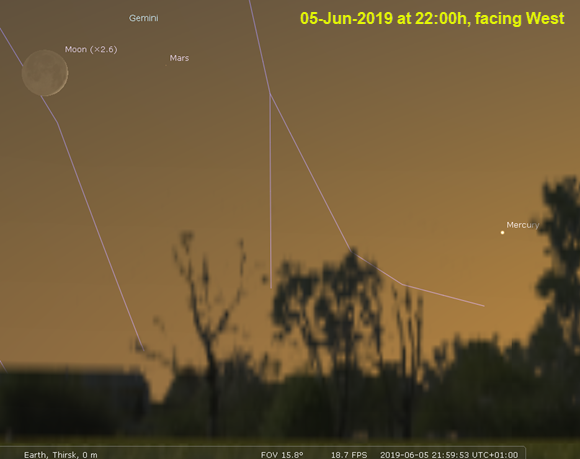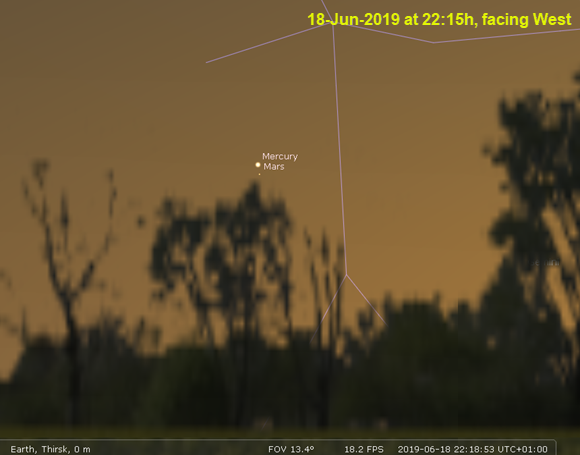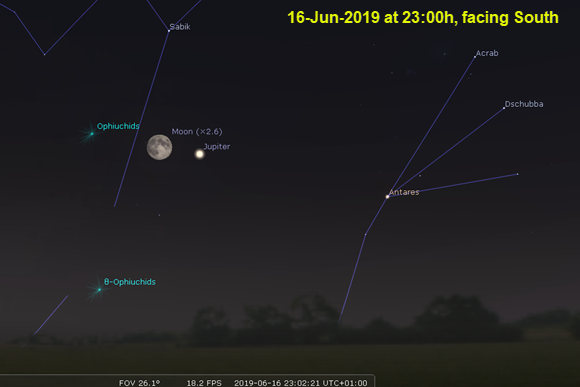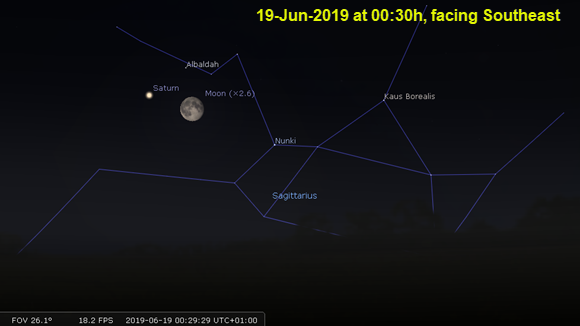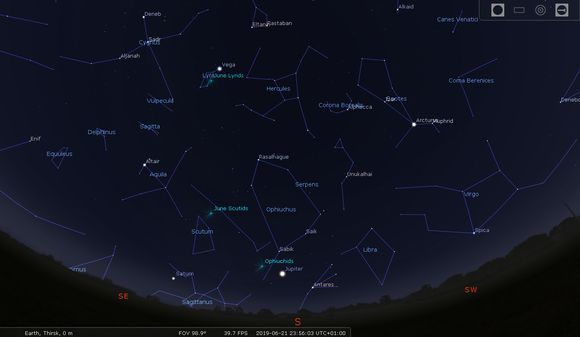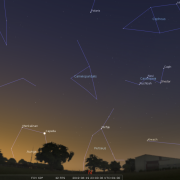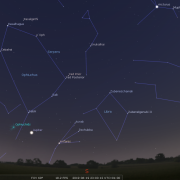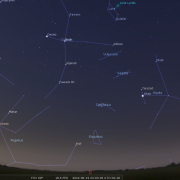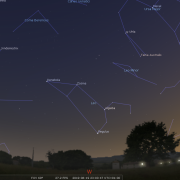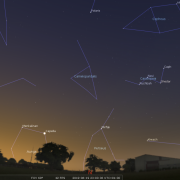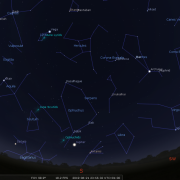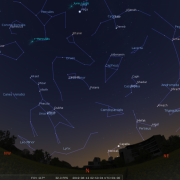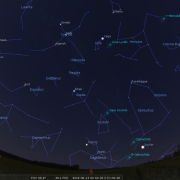In this month's Sky Notes:
Planetary Skylights
Evening Planets

 Mars finally departs our evening sky towards the end of the month, but has one last encounter before being engulfed by twilight. This involves Mercury, also visible low in the WNW throughout much of June.
Mars finally departs our evening sky towards the end of the month, but has one last encounter before being engulfed by twilight. This involves Mercury, also visible low in the WNW throughout much of June.
Mars and Mecury, with The Moon at the beginning of the month, and
by themselves mid-month. Click for full-sized images.
To start with, look for Mercury at the beginning of the month when at its brightest (Mag. -1.0). Given a clear evening and unobstructed WNW views, with a little scrutiny Mercury should be readily visible no higher than a binocular field above the horizon around 45 minutes after sunset. (22:15h).
Mars will be descending down to meet Mercury with the two being in conjunction on the 18th and separated by less than half a degree. Of the two Mercury will still be the most obvious, with ‘ruddy’ Mars just below it. Use binoculars to help pick them out of the twilight around 22:20h before trying with just the naked eye. On the 4th a very slim crescent Moon lies lower left of Mercury and a day later to the left of Mars.

Mighty Jupiter reaches opposition on June 10th, visible all night (what little there is) rising as the sun sets. At Magnitude – 2.6, Jupiter will be very prominent, but is unfortunately well south of the ecliptic and therefore rather low down to the southeast/south horizon. To the observer Jupiter always offers up something of interest to view in the eyepiece, especially around opposition time. For a start it exhibits a disc size of over 46 arc seconds, resembling a bright sixpence with banding across it- even through small instruments.
Residing on the south equatorial belt is the huge ‘storm like’ feature known as the great red spot. Over the last few decades the GRS seems to have shrunk in size, but is still well in excess of Earth’s diameter. Because of the rapid rotation of Jupiter (10hrs approx) it is not always on view, (see times and dates below). When facing in our direction the GRS resembles a pale oval, more subtle in appearance than it used to be. The most dynamic aspect of the Jovian system, the four Galilean moons, are certainly fascinating to follow, throwing up a different configuration each night, even over the course of an hour or so, the relative change in position can be noticed. The Moon lies nearby on the 16th.
Jupiter Galilean moon shadow transits:
- Ganymede: 5th: 00:35-02:55h
- Europa: 8th: midnight-02:25h
Io; 20th/21st: 23:50-02:00h.
The Great Red Spot (GRS):
- Visible on the disk on the following dates: 1st -4th, 6th/7th, 9th- 11th, 14th -16th 19th-23rd, 26th-28th and the 30th.
- The GRS is already on the disk on the 11th and 23rd at 22:20h. Most of the rest are post midnight transits.
 Saturn follows Jupiter over the SE horizon a few hours later, making it a post midnight object for a little while yet and therefore observer unfriendly- unless you are a real night owl. Although not as brilliant as Jupiter, Saturn is nevertheless quite prominent to the naked eye, and like Jupiter it too resides well south of the ecliptic, left of the ‘teapot’ asterism in Sagittarius. Observations are again going to be somewhat compromised due to our atmosphere, but during moments of clarity Saturn is a gorgeous spectacle to observe The Moon lies nearby on the 23rd.
Saturn follows Jupiter over the SE horizon a few hours later, making it a post midnight object for a little while yet and therefore observer unfriendly- unless you are a real night owl. Although not as brilliant as Jupiter, Saturn is nevertheless quite prominent to the naked eye, and like Jupiter it too resides well south of the ecliptic, left of the ‘teapot’ asterism in Sagittarius. Observations are again going to be somewhat compromised due to our atmosphere, but during moments of clarity Saturn is a gorgeous spectacle to observe The Moon lies nearby on the 23rd.
Meteors

If you are a very early riser, look out for some shooting stars around May 5th-7th, when the eta Aquarid meteor shower reaches a peak. The actual peak falls on the 6th. This is one of two meteor showers associated with debris particles deposited over time by comet Halley, the other shower being the Orionids seen in late October.
Eta Aquarids have a ZHR (zenith hourly rate) approaching 30, but with Aquarius only just rising in the SE shortly before dawn, observations from the UK are always somewhat restricted. The radiant of the shower lies close to eta Aquarius, one of the stars making up the "water jar" in the otherwise faint constellation of Aquarius. View around 4am to the south and east.
The Summer Solstice and Noctilucent Cloud
The summer solstice in the northern hemisphere falls on June 21st, when the Sun reaches its greatest altitude in the sky on the ecliptic; the path it takes across the sky during a year.
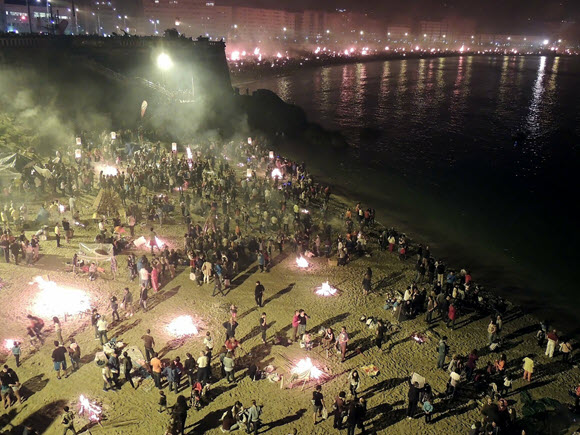
On Sun 23-Jun-2019, 2 days after The Summer Solstice, Spain Celebrates San Juan Day
with beach bonfires. Taken Jul-2014 by Jose Cernadas.
It is surprising how many people wrongly assume that Earth is closer to the Sun at this time of year; in fact the opposite is true. Earth is actually furthest from the Sun on July 4th at almost 95 million miles (153m km), nearly 3m miles (4½ m km) more than when at its closest approach in early January. It is the inclination of the northern hemisphere towards the Sun which causes days to ‘grow longer’ and feel warmer due to the higher concentration of sunlight per unit area. Think of this as being like a spot light directed onto to the palm of your hand, your palm feels hotter under direct radiation, whereas when the light is tilted, the angle reduces the heat intensity. The actual intensity of solar radiation in June is equivalent to approximately 1.2KW of heat for each square metre, although sometimes it feels as if someone’s forgotten to feed the meter.
Although known as the longest day, earliest sunrise and latest sunset times do not occur on the summer solstice date. Earliest sunrise falls around June 16th (from Whitby: 04:25h) whilst latest sunset occurs on June 25th (Whitby: 21:42h). It is the duration of useable daylight which reaches a maximum on the 21st, at just over 17 hours, with a meagre 4 hours of semi darkness.
Noctilucent cloud
With bright twilight persisting well into the night, throughout June and into the July, watch out for the beautiful type of cloud formation seen only at this time of year known as Noctilucent cloud.
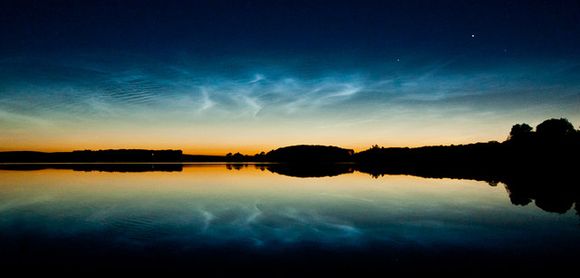
Noctilucent cloud formation, Mochrum Loch. Taken Jul-2011 by David Baird.
These delicate formations appear above the northern horizon, long after sunset, often around midnight. Shining quite brightly, Noctilucent cloud is filamentary in structure, having a characteristic silvery-blue colour. It forms almost exclusively between latitudes 50 and 60 degrees north, high in the upper atmosphere: 50 miles (80km) up five times higher than normal clouds.
It is thought that this type of cloud forms when water vapour condenses at the low temperatures that prevail at such altitudes onto particles suspended in the air. More frequent sightings of Noctilucent cloud over the last half century may indicate that these particles could be a result of industrial pollution, perhaps from increased air traffic. Do keep watch!
June 2019 Sky Charts
|
Looking North
Mid-June - 23:00h |
Looking South |
|
Looking East
Mid-June - 23:00h |
Looking West
Mid-June - 23:00h |
|
Northern Aspect
Mid-June - 23:00h |
Southern Aspect
Mid-June - 23:00h |
| Looking North (Early) Mid-June - 03:05h |
Looking South (Early) Mid-June - 03:00h |
Additional Image Credits:
- Planets and Comets where not otherwise mentioned: NASA
- Sky Charts: Stellarium Software
- Log in to post comments

